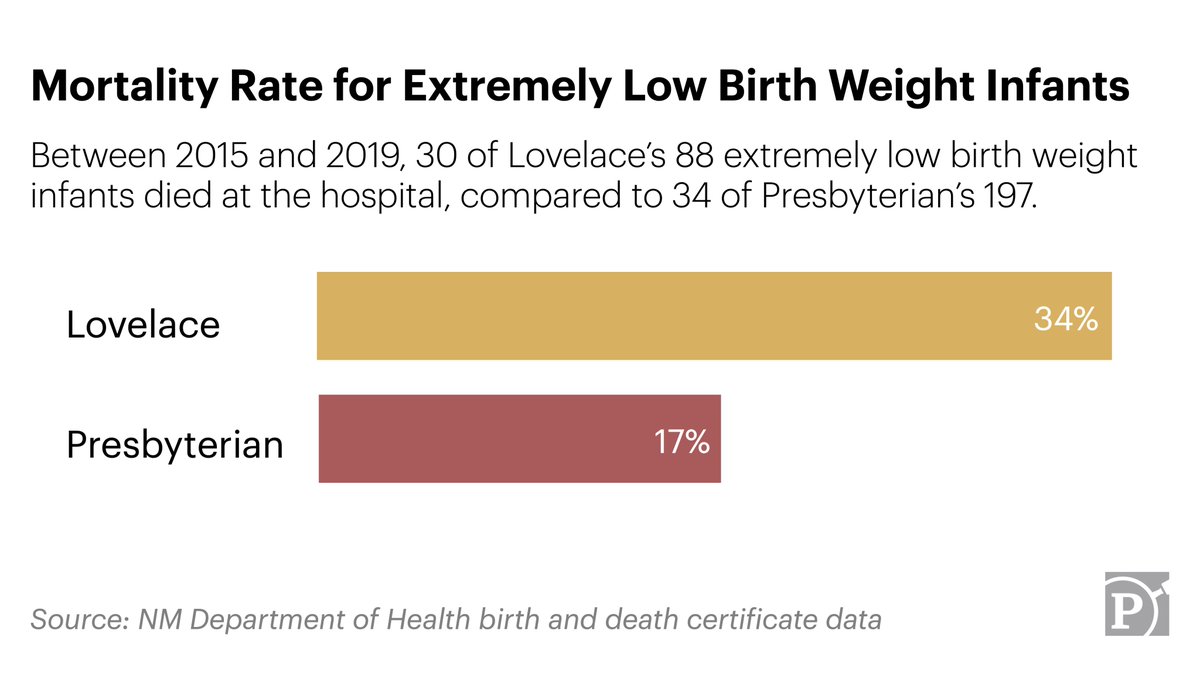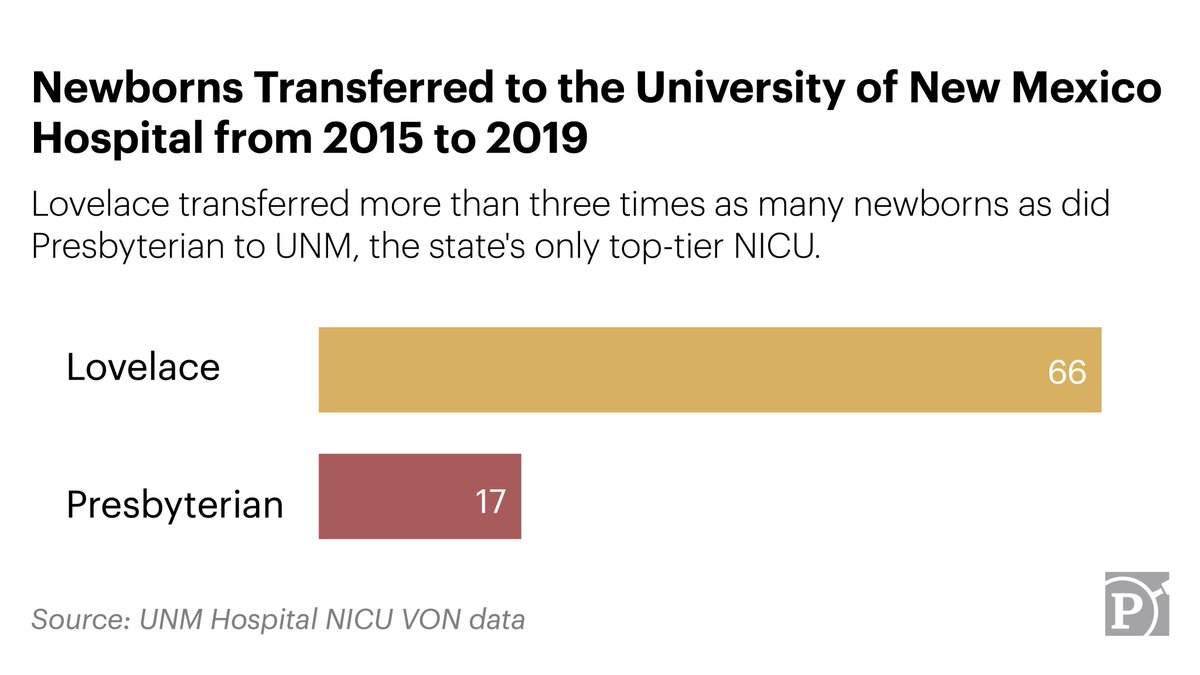1/ When three clinicians shared concerns with LRN reporter @BryantFurlow about how Lovelace Women’s — New Mexico’s largest for-profit maternity hospital — cared for its most premature babies, he decided to investigate. This is what he found.
2/ Extremely preterm babies died at Lovelace with striking frequency. How often? Up to twice the rate they did at Presbyterian, a similarly situated maternity facility just a few miles away.
3/ Lovelace also transferred more than 3x as many newborns as did Presbyterian to the University of New Mexico Hospital, the state’s only top-tier NICU, where the state’s sickest newborns are sent for care.
4/ All told, between 2015 and 2019, *nearly half* of the extremely preterm babies born at Lovelace either died at the hospital or were transferred to UNM.
5/ Lovelace and Presbyterian, which had a similar number of births in 2019, are New Mexico’s largest maternity centers. Between 2010 and 2019, they delivered 28% of babies born statewide, and 37% of the state’s extremely preterm babies.
6/ Lovelace objected to our analyses, claiming its neonatal death rate for *all* NICU-admitted newborns — which includes lower-risk full-term babies AND premature babies — is “significantly lower than the national average,” and has declined over time.
7/ But here’s the thing. We’ve been clear our investigation focuses on extremely preterm newborns — not *all* NICU-admitted newborns — because they’re the hospital’s most at-risk babies. https://www.propublica.org/article/the-two-hospitals-have-similar-infant-death-rates-until-you-look-at-extremely-premature-babies">https://www.propublica.org/article/t...
8/ Full-term babies, who are generally lower-risk, make up a much larger proportion of the hospital’s NICU population. So to group them with extremely preterm newborns would obscure the death rate for the hospital’s most vulnerable babies.
9/ A spokesperson for Lovelace also said our investigation sought “to undermine [its] quality of care” through a “misinterpretation of data.” But she didn’t respond when asked how the hospital’s data had been misinterpreted.
10/ It was incredibly difficult to obtain and analyze the data, but we didn’t misinterpret it. We even wrote about the methodology behind our investigation so you can judge for yourself  https://abs.twimg.com/emoji/v2/... draggable="false" alt="🙃" title="Auf den Kopf gestelltes Gesicht" aria-label="Emoji: Auf den Kopf gestelltes Gesicht"> https://www.propublica.org/article/how-we-investigated-death-rates-for-extremely-preterm-babies-in-this-states-largest-maternity-hospitals">https://www.propublica.org/article/h...
https://abs.twimg.com/emoji/v2/... draggable="false" alt="🙃" title="Auf den Kopf gestelltes Gesicht" aria-label="Emoji: Auf den Kopf gestelltes Gesicht"> https://www.propublica.org/article/how-we-investigated-death-rates-for-extremely-preterm-babies-in-this-states-largest-maternity-hospitals">https://www.propublica.org/article/h...
11/ But back to the issue.
Experts said the findings were troubling and should be investigated. But it’s unclear who would conduct the investigation.
Experts said the findings were troubling and should be investigated. But it’s unclear who would conduct the investigation.
12/ That’s because the federal government doesn’t set standards for NICUs — regulation of these units falls to individual states — and New Mexico has no NICU-specific legal or regulatory authority.
13/ Put simply, New Mexico requires *virtually no oversight* of its neonatal intensive care facilities or of babies’ hospital outcomes.
14/ But this is not the case in 31 other states, which have some measure of NICU regulation and oversight, showing it can be done! https://www.propublica.org/article/no-one-in-this-state-is-officially-tracking-the-quality-of-care-in-neonatal-centers">https://www.propublica.org/article/n...
15/ California, for example, has both state and NGO oversight of NICU performance. And Texas requires independent on-site verification of NICU levels of care, which includes reviewing patient records and confirming the credentials of staff specialists.
16/ Here’s why this matters.
Because New Mexico doesn’t analyze or publicly disclose NICU data for specific hospitals, parents are left in the dark about where to seek care.
Because New Mexico doesn’t analyze or publicly disclose NICU data for specific hospitals, parents are left in the dark about where to seek care.
17/ New Mexico is not alone. Nationwide, there’s a “wall of silence that families and the public face with regard to the quality of care in NICUs,” said Dr. David C. Goodman, a professor at The Dartmouth Institute for Health Policy & Clinical Practice at Dartmouth College.
18/ Parents literally have no way to know which birth centers have the best track records for specific newborn risk groups, like extremely preterm babies.
19/ “Hospital transparency could save babies’ lives and save New Mexico families in the future from devastating heartbreak,” said a Lovelace clinician.
20/ Instead, families have to contend with a system that doesn’t collect or share data on neonatal centers, making it incredibly challenging to sort out what’s wrong and figure out how to fix it. https://www.propublica.org/article/i-received-tips-to-look-into-how-a-hospital-treated-premature-babies-getting-data-was-nearly-impossible">https://www.propublica.org/article/i...
21/ You can read the investigation here: https://www.propublica.org/article/the-two-hospitals-have-similar-infant-death-rates-until-you-look-at-extremely-premature-babies">https://www.propublica.org/article/t...
22/ And here’s the Spanish translation of our story: https://www.propublica.org/article/los-dos-hospitales-tienen-tasas-de-mortalidad-infantil-similares-hasta-que-se-observa-a-los-bebes-extremadamente-prematuros">https://www.propublica.org/article/l...

 Read on Twitter
Read on Twitter




